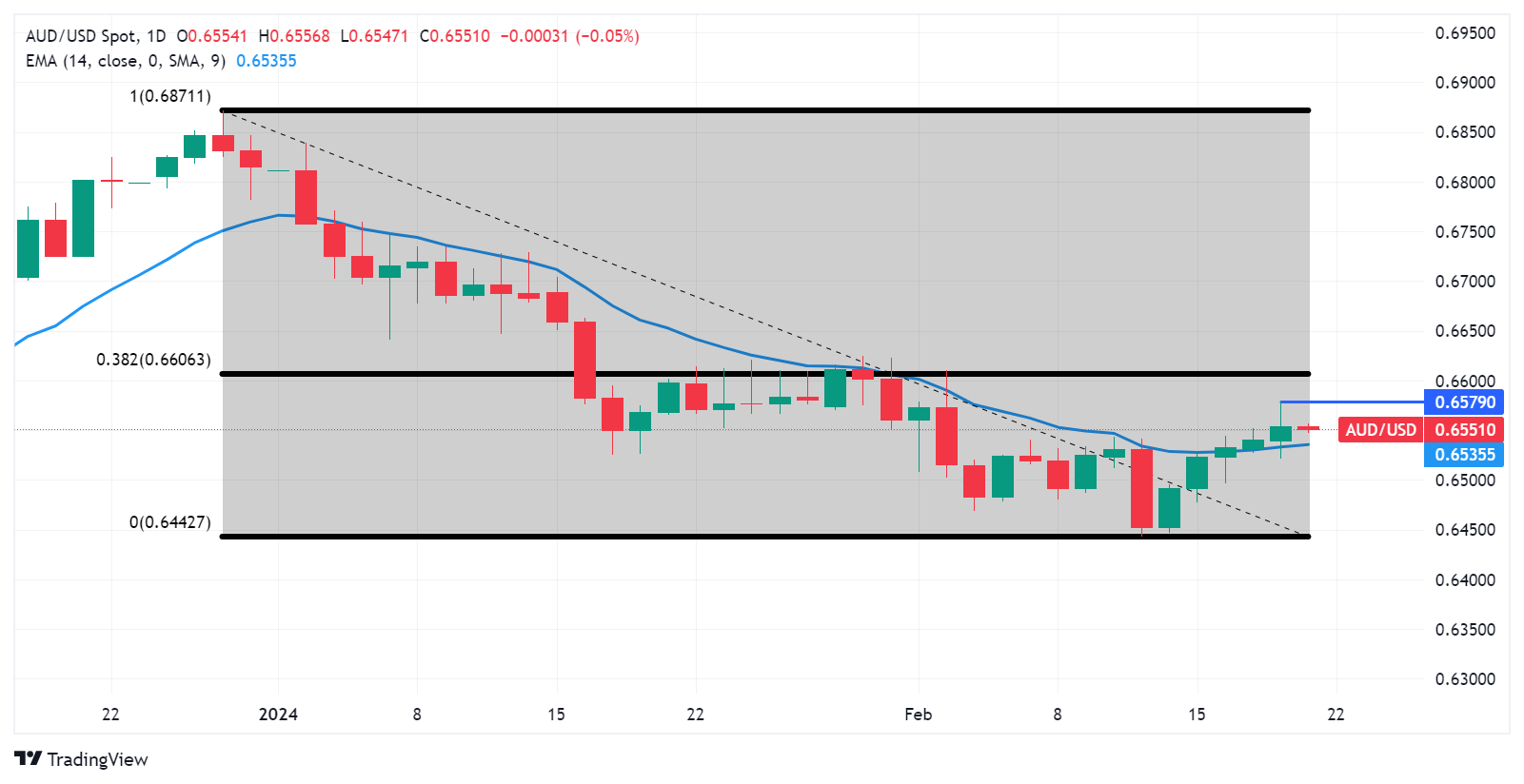Australian Dollar could extend its gains on a subdued US Dollar.
Australia’s ASX 200 declines following overnight losses on Wall Street.
RBA Meeting Minutes shifted market sentiment towards the likelihood of no rate cuts anytime soon.
Greenback faces challenges as US Treasury yields decline ahead of FOMC Minutes.
The Australian Dollar (AUD) seems to extend its winning streak for the sixth consecutive session on Monday. The AUD receives upward support following the release of the Reserve Bank of Australia’s (RBA) meeting minutes, which shifted market sentiment toward the likelihood of no rate cuts soon. Additionally, the decline in the US Dollar (USD) provides further upward support for the AUD/USD pair, possibly due to weaker US Treasury yields ahead of the Federal Open Market Committee (FOMC) Minutes scheduled for Wednesday.
Australian Dollar (AUD) may encounter challenges from weaker Aussie money markets as the S&P/ASX 200 Index declines for the second consecutive session, following overnight losses on Wall Street. This decline is attributed to subdued mining stocks and metals prices. Furthermore, the Australian Bureau of Statistics released mixed Wage Price Index data for the fourth quarter, which does not appear to be influencing the Aussie Dollar (AUD) significantly.
The US Dollar Index (DXY) faces downward pressure as market expectations lean towards no further rate hikes by the Federal Reserve in upcoming meetings. According to the CME FedWatch Tool, the likelihood of a Fed cut has notably decreased to 8.5% and 30.7% for March and May, respectively. The market is now projecting the start of easing to begin in June, with a probability of 54.3%.
Daily Digest Market Movers: Australian Dollar appreciates on weaker US Dollar
Australian Wage Price Index (QoQ) grew by 0.9% in the fourth quarter as expected, lower than the previous rise of 1.3%. The index rose by 4.2% year-over-year, surpassing the market expectation to be unchanged at 4.1%.
Westpac Leading Index (MoM) declined by 0.1% in January against the previous reading of flat 0.0%.
The ANZ-Roy Morgan Consumer Confidence improved to 82.8 this week from 82.6 prior. Remarkably, the index has now spent a record 55 consecutive weeks below the mark of 85.
RBA’s Meeting Minutes revealed that the Board deliberated on the possibility of raising rates by 25 basis points (bps) or keeping rates unchanged. While recent data indicated that inflation would return to target within a reasonable timeframe, it was acknowledged that this process would “take some time.” Consequently, the board agreed that it was prudent not to rule out another rate hike.
The People’s Bank of China (PBoC) implemented an unprecedented reduction in the five-year Loan Prime Rate (LPR) by 25 basis points, marking the largest decrease on record, from 4.20% to 3.95%. This move was aimed at bolstering the housing market. However, analysts suggest that the overall impact on stimulating the economy may be marginal.
The Federal Reserve’s dot plot for this year indicates an expectation of 75 basis points in rate cuts, whereas the Fed funds futures market is pricing in approximately 89 basis points in cuts.
ANZ anticipates that the Federal Reserve (Fed) will commence rate cuts from July 2024.
3-Month and 6-Month US Bills auctioned at 5.23% and 5.1%, respectively.
Technical Analysis: Australian Dollar hovers around the major level of 0.6550
The Australian Dollar traded around the major level at 0.6550 on Wednesday. A break below this major level could meet the immediate support around the 14-day Exponential Moving Average (EMA) at 0.6535 followed by the psychological support level of 0.6500. On the upside, the AUD/USD pair could retest the three-week high at 0.6579 followed by the resistance zone around the psychological level of 0.6600 and 38.2% Fibonacci retracement level of 0.6606.
AUD/USD: Daily Chart

Australian Dollar price today
The table below shows the percentage change of Australian Dollar (AUD) against listed major currencies today. Australian Dollar was the strongest against the Japanese Yen.
USD
EUR
GBP
CAD
AUD
JPY
NZD
CHF
USD
-0.03%
-0.05%
-0.08%
-0.18%
0.04%
-0.32%
-0.10%
EUR
0.03%
-0.02%
-0.05%
-0.15%
0.07%
-0.29%
-0.07%
GBP
0.04%
0.02%
-0.03%
-0.14%
0.10%
-0.27%
-0.05%
CAD
0.08%
0.04%
0.02%
-0.12%
0.12%
-0.25%
-0.03%
AUD
0.19%
0.15%
0.14%
0.11%
0.21%
-0.15%
0.06%
JPY
-0.04%
-0.06%
-0.09%
-0.12%
-0.21%
-0.37%
-0.15%
NZD
0.31%
0.29%
0.27%
0.25%
0.13%
0.36%
0.23%
CHF
0.10%
0.07%
0.06%
0.03%
-0.07%
0.14%
-0.21%
The heat map shows percentage changes of major currencies against each other. The base currency is picked from the left column, while the quote currency is picked from the top row. For example, if you pick the Euro from the left column and move along the horizontal line to the Japanese Yen, the percentage change displayed in the box will represent EUR (base)/JPY (quote).
Risk sentiment FAQs
In the world of financial jargon the two widely used terms “risk-on” and “risk off” refer to the level of risk that investors are willing to stomach during the period referenced. In a “risk-on” market, investors are optimistic about the future and more willing to buy risky assets. In a “risk-off” market investors start to ‘play it safe’ because they are worried about the future, and therefore buy less risky assets that are more certain of bringing a return, even if it is relatively modest.
Typically, during periods of “risk-on”, stock markets will rise, most commodities – except Gold – will also gain in value, since they benefit from a positive growth outlook. The currencies of nations that are heavy commodity exporters strengthen because of increased demand, and Cryptocurrencies rise. In a “risk-off” market, Bonds go up – especially major government Bonds – Gold shines, and safe-haven currencies such as the Japanese Yen, Swiss Franc and US Dollar all benefit.
The Australian Dollar (AUD), the Canadian Dollar (CAD), the New Zealand Dollar (NZD) and minor FX like the Ruble (RUB) and the South African Rand (ZAR), all tend to rise in markets that are “risk-on”. This is because the economies of these currencies are heavily reliant on commodity exports for growth, and commodities tend to rise in price during risk-on periods. This is because investors foresee greater demand for raw materials in the future due to heightened economic activity.
The major currencies that tend to rise during periods of “risk-off” are the US Dollar (USD), the Japanese Yen (JPY) and the Swiss Franc (CHF). The US Dollar, because it is the world’s reserve currency, and because in times of crisis investors buy US government debt, which is seen as safe because the largest economy in the world is unlikely to default. The Yen, from increased demand for Japanese government bonds, because a high proportion are held by domestic investors who are unlikely to dump them – even in a crisis. The Swiss Franc, because strict Swiss banking laws offer investors enhanced capital protection.
Information on these pages contains forward-looking statements that involve risks and uncertainties. Markets and instruments profiled on this page are for informational purposes only and should not in any way come across as a recommendation to buy or sell in these assets. You should do your own thorough research before making any investment decisions. FXStreet does not in any way guarantee that this information is free from mistakes, errors, or material misstatements. It also does not guarantee that this information is of a timely nature. Investing in Open Markets involves a great deal of risk, including the loss of all or a portion of your investment, as well as emotional distress. All risks, losses and costs associated with investing, including total loss of principal, are your responsibility. The views and opinions expressed in this article are those of the authors and do not necessarily reflect the official policy or position of FXStreet nor its advertisers. The author will not be held responsible for information that is found at the end of links posted on this page.
If not otherwise explicitly mentioned in the body of the article, at the time of writing, the author has no position in any stock mentioned in this article and no business relationship with any company mentioned. The author has not received compensation for writing this article, other than from FXStreet.
FXStreet and the author do not provide personalized recommendations. The author makes no representations as to the accuracy, completeness, or suitability of this information. FXStreet and the author will not be liable for any errors, omissions or any losses, injuries or damages arising from this information and its display or use. Errors and omissions excepted.
The author and FXStreet are not registered investment advisors and nothing in this article is intended to be investment advice.
>>> Read full article>>>
Copyright for syndicated content belongs to the linked Source : FXStreet – https://www.fxstreet.com/news/australian-dollar-strengthens-as-rba-minutes-indicate-no-imminent-rate-cuts-202402210153































